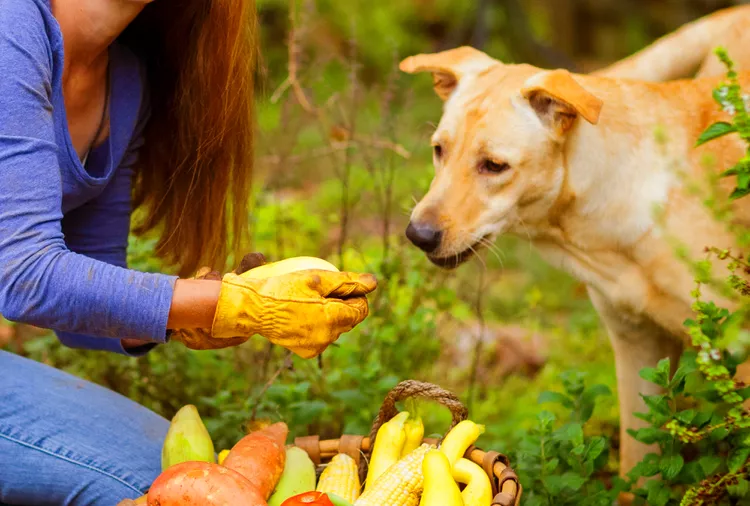
A lot of dogs really enjoy chomping on fruits and vegetables. So, the next time you’re preparing dinner, you may find yourself wondering—can dogs eat squash? Luckily, dogs don’t have to sit this one out. Learn how to share squash with your pup.
Squash comes in a lot of varieties, and luckily for your dog, most of these are safe! Types of squash you can safely feed your dog include zucchini, pumpkin, spaghetti squash, yellow squash, butternut squash, and acorn squash.
No matter which variation you choose, washed, cooked squash is the safest option for your dog. The stems, skins, and seeds can be choking hazards or potentially cause a blockage in the stomach or intestines. Stick to the flesh of this fruit if you're planning to feed squash to your dog.
Some nutritional benefits of squash for dogs include:
If you want to feed canned pumpkin to your dog, make sure it’s plain pumpkin. Pumpkin pie filling is not safe for dogs. Additionally, do not feed your dog any pumpkin items that contain the sugar substitute xylitol, which is toxic to dogs.
For feeding guidelines, Small dogs can have 1-2 teaspoons of squash per day. Larger dogs can have 1-3 tablespoons per day.
If you give your dog too much squash, you could impact their nutritional balance. At least 90% of your dog’s daily caloric intake needs to come from their well-balanced, nutritionally complete diet that meets guidelines set by the Association of American Feed Control Officials (AAFCO). Make sure to speak with your veterinarian if you plan to change your dog’s diet.
Additionally, although most food allergies in dogs occur due to the protein source in the food, it’s possible for a dog to be allergic to squash. Symptoms of a food allergy include itchiness, skin rashes, vomiting, and/or diarrhea. If your dog develops skin issues after eating squash, stop feeding them squash and consult with your veterinarian.
Squash is in great company with several other dog-safe fruits and vegetables. These include:

How Long Should Kittens Stay With Their Mothers?
Kittens need their mothers for more than just milk. Find out how long kittens should stay with their mothers and why.
15 Adorable Persian Cats Names
Pick the perfect Persian cat name from this list of top options, including names that describe your cat's beauty and or regal personality.
Can Cats Eat Blueberries?
Learn all about the potential health concerns, benefits, and safe ways to feed blueberries to cats.
Cat Food Ingredients to Avoid
When checking the nutrition content of cat food, look for ingredients that are not healthy or show it is of poor quality. Avoid these 3 ingredients.
10 Obscure, Little-known Canine Facts in Honor of National Dog Day
With National Dog Day upon us, it's time to celebrate everything about our favorite pets—even the weirder stuff. Here are 10 obscure facts about dogs you probably didn't know.
Why Is My Dog Scooting Across the Floor?
If your dog is scooting its rear end across the floor, it may be impacted or infected anal glands. Learn how to identify and prevent this problem.
Why Do Dogs Lick Their Wounds?
Dogs lick their wounds in response to pain or irritation, but in most cases, the licking of wounds should not be allowed.
What to Give Your Dog If It Has Diarrhea
If your dog has diarrhea, you'll want to quickly fix the problem and get your dog's poop back to normal. Find out what's safe to give your dog.
Keeshond: Dog Breed Characteristics & Care
Learn about the keeshond dog, also known as the Dutch Barge Dog. This fluffy spitz breed was bred to guard, but also makes a friendly companion.
How to Train Your Cat to Accept Mirror Reflections
Cats and mirrors can be a source of amusement or a trigger for aggressive behavior. Learn how to soothe an upset cat when it attacks a mirror.
Why Do Cats Like Catnip?
Catnip can make some cats react in interesting ways. Learn why cats like catnip so much, why only some cats react to it, and why others seem immune.
How to Stop Cats From Biting and Scratching
Cats learn to bite and scratch as kittens and may need to be retrained when they grow older. These behaviors can be changed with time and patience.
How to Stop Your Cat From Chewing Electrical Cords
Cats are known to pounce and attack inanimate objects, like electrical cords. Learn how to prevent your cat from ambushing objects that may harm it.
What to Do if Your Cat Is Peeing in the Bathtub
If your cat is peeing in the bathtub on a regular basis it means there is a problem. Find out if it is a health, behaviorial, or other type of issue.
Old English Sheepdog: Dog Breed Characteristics & Care
Learn about Old English sheepdogs, a hard-working breed with much more to offer. It's known for its adorably shaggy coat and friendly personality.
Bernedoodle: Dog Breed Characteristics & Care
The Bernedoodle is a hybrid dog breed created by crossing Bernese mountain dogs with poodles. Learn about their fun-loving personality and common health issues.
6 Egyptian Dog Breeds and Their Rich Histories
Some of the oldest dog breeds, like salukis and basenjis, date back to ancient Egypt. These six canines had their start in the land of the Nile.
Understanding Dog Growling
Get information on how to interpret dog growling and how to keep it from escalating to dog aggression.
How to Train Your Dog to Live With Another Dog
When you add a second dog to your household, it's natural that there will be an adjustment period. Learn how to get two dogs to become acquainted.
How to Train Your Dog to Be off the Leash
Letting your dog off the leash can create dangerous situations. Learn how to train your dog so you can trust it to play off the leash.